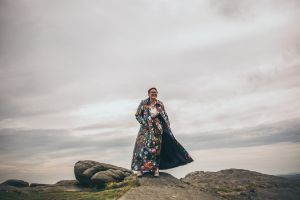Concert
silent green 3
Laura Bowler // Global Breath 2

Laura Bowler © Robin Clewley
Described by The Arts Desk as “a triple threat composer-performer provocatrice,” Laura Bowler opens this evening with three works for vocal, electronics and video commissioned from a trio of composers: Nwando Ebizie, Sivan Cohen Elias and Diana Soh. Each of these composers has chosen a very different starting point, ranging from French children’s stories through autobiographical rituals and on to the fragmentation of the self and the creation of avatars. After this, a variety of compositions for brass can be heard as part of Global Breath, the research project initiated by Marco Blaauw in which he undertakes an artistic exploration of the universality of trumpet sounds. “Monochrome, light blue darkness” by Milica Djordjević resembles an “immersive painting or a sculpture”: it is “a comprehensive study of crystallised tones.” In “Shimmer”, the Japanese composer Dai Fujikura explores how the trumpet can sound as sensual as possible without awakening the impression of a fanfare or a powerful brass sound. In “Shallow Grave” Liza Lim investigates music’s potential to connect people even beyond death and allows us to hear a “Neolithic” ceramic horn whose roots extend back over 3,000 years. Georg Friedrich Haas expresses solidarity with the Black Lives Matter movement with the work “I can’t breathe”.
Programme
Laura Bowler: Three
Sivan Cohen Elias
Who-He-Huh
solo multimedia piece for a singer and fixed electronics (2024)
Commisioned by Ralph Vaughan Williams Trust, Hinrichsen Foundation and Arts Council of England
World premiere
Nwando Ebizie
Dahlia (and you will be there forever and ever)
solo multimedia piece for a singer and fixed electronics (2024)
Commisioned by Ralph Vaughan Williams Trust, Hinrichsen Foundation, Diaphonique and Arts Council of England
World premiere
Diana Soh
La Ville-Zizi
for solo voice and electronics (2025)
Commisioned by Ralph Vaughan Williams Trust, Hinrichsen Foundation, Diaphonique and Arts Council of England
World premiere
With
Laura Bowler – soloist, producer
Sivan Cohen Elias – electronics
Sam Redway – producer, dramaturg, movement director
Global Breath 2
Milica Djordjević
Monochrome, light blue darkness
for eight wind instruments (2024)
Commisioned by WDR and New Music Dublin
Edivaldo Ernesto
Intervention
Dai Fujikura
Shimmer
for trumpet solo, performed by two double bell trumpets (2025)
Commissioned by Marco Blaauw, sponsored by Musikfonds e. V. and Kunststiftung NRW
Liza Lim
Intervention
Liza Lim
Shallow Grave
for “Neolithic” ceramic horn and alto trumpet (2023)
Commissioned by Marco Blaauw, sponsored by Musikfonds e. V. and Kunststiftung NRW
Georg Friedrich Haas
I can’t breathe
for trumpet solo (2014)
in memoriam of Eric Garner
with a choreography by Ernesto Edivaldo
Commissioned by Ensemble Musikfabrik, supported by the Ministry for Family, Children, Youth, Culture and Sport of North-Rhine Westphalia
With
Marco Blaauw – alto trumpet, double bell trumpet, “Neolithic” ceramic horn, trumpet
Edivaldo Ernesto – choreography, dance
Liza Lim – speaker
Laura Vukobratović – double bell trumpet
The Monochrome Project
Marco Blaauw, Christine Chapman, Mathilde Conley, Rike Huy, Bob Koertshuis, Nathan Plante, Markus Schwind, Laura Vukobratović – trumpet
“Three” by Laura Bowler is commissioned with funds from the Ralph Vaughan Williams Trust, Hinrichsen Foundation, Diaphonique and Arts Council of England. Supported by Britten Pears Arts.
Global Breath is supported by Ernst von Siemens Music Foundation, Musikfonds Neustart Kultur and Kunststiftung NRW.
 |  |